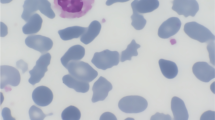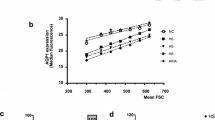Summary
We screened for increased osmotic fragility of erythrocytes in 1464 healthy German blood donors. The osmotic fragility was determined by an acidified glycerol lysis test (AGLT) using glycerol-sodium phosphate-buffered NaCl solution. Since the original test described by Zanella et al. [23] showed only low specificity for hereditary spherocytosis, we used a modification with 0.0093M sodium phosphate-buffered glycerol-saline solution, pH 6.90, instead of the original 0.0053M sodium phosphate buffer, pH 6.85. Sixteen of the donors (1.1%) had a “pathologic result,” similar to that of 32 patients with hereditary spherocytosis: AGLT 50 <5 min (“half-time of AGLT, defining normal and pathologic results). The osmotic fragility of the erythrocytes from 12 of these donors was further investigated using the conventional test with hypotonic NaCl solutions. With one exception, increased osmotic fragility was verified in all of them by both tests. Further hematologic data showed a mild reticulocytosis (2% and 2.6%) in two of the donors. One donor had a moderate reticulocytosis of 6.5%, probably due to a mild, previously undiagnosed spherocytosis; 99 of the donors had an intermediate result (AGLT 50: 5–30 min). Hypotonic lysis of their erythrocytes by the conventional method showed a normal result; there were no signs of increased hemolysis. Thus they are not definitely regarded as having increased osmotic fragility of their erythrocytes. Erythrocyte osmotic fragility shows a wide distribution range in the normal population and might be normally distributed. Thus the blood donors with “pathologic AGLT (<5 min)” probably represent only one end of a continuum of salt-dependent hemolysis, and not a separate entity. However, they did show additional minor signs of a functional defect of the erythrocyte membrane and therefore could be carriers of a spherocytosis trait. The frequency of carriers of an erythrocyte membrane defect (possible spherocytosis trait) could be as high as 1.1% in the general population and would distinctly exceed the prevalence of patients with apparent spherocytosis (0.02%).
Similar content being viewed by others
References
Acharya J, Ferguson IL, Cassidy AG, Grimes AJ (1987) An improved acidified glycerol lysis test (AGLT) used to detect spherocytosis in pregnancy. Br J Haematol 65: 343–345
Agre P, Casella JF, Zinkham WH, McMillan C, Bennett V (1985) Partial deficiency of erythrocyte spectrin in hereditary spherocytosis. Nature 314: 380–383
Agre P, Asimos A, Casella JF, McMillan C (1986) Inheritance pattern and clinical response to splenectomy as a reflection of erythrocyte spectrin deficiency in hereditary spherocytes. N Engl J Med 315: 1579–1583
Bucx MJL, Breed WPM, Hoffmann JJM (1988) Comparison of acidified glycerol lysis test, Pink test and osmotic fragility test in herditary spherocytosis: effect of incubation. Eur J Haematol 40: 227–231
Coetzer TL, Lawler J, Liu S-C, Prchal JT, Gualtieri RJ, Brain MC, Dacie JV, Palek J (1988) Partial ankyrin and spectrin deficiency in severe, atypical hereditary spherocytosis. N Engl J Med 318: 230–234
Dacie J (1985) The hemolytic anemias, vol. I. 3rd edn. Churchill Livingstone, Edinburgh, pp 138, 158
Dacie J, Lewis S (1975) Practical hematology. Churchill Livingstone, Edinburgh
Eber SW (1991) Correlation between the clinical severity, erythrocyte morphology and abnormal membrane skeleton in hereditary spherocytosis and elliptocytosis. Klin Paediatr 203: 284–295
Eber SW, Armbrust R, Schröter W (1990) Variable clinical severity of hereditary spherocytosis: relation to erythrocytic spectrin concentration, osmotic fragility and autohemolysis. J Pediatr 117: 409–416
Godal H, Heisto H (1981) High prevalence of increased osmotic fragility of red blood cells in Norwegian blood donors. Scand J Haematol 27: 30–34
Gottfried EL, Robertson NA (1974) Glycerol lysis time as a screening test for erythrocyte disorders. J Lab Clin Med 84: 746–751
Lux SE (1983) Disorders of the red cell membrane skeleton. In: Wyngaarden JB, Fredericksen DS, Goldstein JL, Brown MS (eds) The metabolic basis of inherited disease, 5th edn. McGraw Hill, NY, p 1573
Lux S, Bedrosian C, Shalev O, Morris M, Chasis J, Davies K, Savvides P, Telen M (1990) Deficiency of band 3 in dominant hereditary spherocytosis with normal spectrin content. Clin Res 38: 300 (Abstract)
Lux SE, Tse WT, Menninger JC, John KM, Harris P, Shalev O, Chilcote RR, Marchesi SL, Watkins PC, Bennett V, McIntosh S, Collins FS, Francke U, Ward DC, Forget BG (1990) Hereditary spherocytosis associated with deletion of human erythrocyte ankyrin gene on chromosome 8. Nature 345: 736–739
Morton NE, Mackinney AA, Kosower N, Schilling RF, Gray MP (1962) Genetics of spherocytosis. Am J Human Genet 14: 170–184
Nathan DG, Oski FA (1987) Hematology of infancy and childhood. Saunders, Philadelphia, p 266
Parpart AK, Lorenz PB, Parpart ER, Gregg JR, Chase A (1947) The osmotic resistance (fragility) of human red cells. J Clin Invest 26: 636–645
Rutherford CJ, Postlewaight BF, Hallowes M (1986) An evaluation of the acidified glycerol lysis test. Br J Haematol 63: 119–121
Rybicki AC, Heath R, Wolf JL, Lubin B, Schwartz RS (1988) Deficiency of protein 4.2 in erythrocytes from a patient with a Coombs-negative hemolytic anemia. Evidence for a role of protein 4.2 in stabilizing ankyrin on the membrane. J Clin Invest 81: 893–901
Schröter W, Kahsnitz E (1983) Diagnosis of hereditary spherocytosis in newborn infants. J Pediatr 103: 460–463
Vettore L, Zanella A, Molaro GL, De Matteis MC, Pavesi M, Mariani M (1984) A new test for the laboratory diagnosis of spherocytosis. Acta Hematol 72: 258–263
Winkelmann JC, Leto TL, Forget BG (1989) Spectrin genes. In: Agre P, Parker JC (eds) Red blood cell membranes. Hematology, vol 11. Decker, New York, pp 111–134
Zanella A, Izzo C, Rebulla P, Zanuso F, Perroni L, Sirchia G (1980) Acidified glycerol lysis test: a screening test for spherocytosis. Br J Haematol 45: 481–486
Author information
Authors and Affiliations
Rights and permissions
About this article
Cite this article
Eber, S.W., Pekrun, A., Neufeldt, A. et al. Prevalence of increased osmotic fragility of erythrocytes in German blood donors: Screening using a modified glycerol lysis test. Ann Hematol 64, 88–92 (1992). https://doi.org/10.1007/BF01715351
Received:
Accepted:
Issue Date:
DOI: https://doi.org/10.1007/BF01715351




